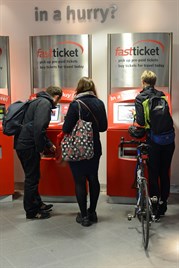 Read the peer reviews for this feature.
Read the peer reviews for this feature.
Download the graphs for this feature.
Rail passengers are no more aware of how their fares are constructed than motorists understand the detailed components that make one car insurance quotation cheaper than another.
Increasingly, travellers simply search for the most suitable compromise between convenience and cost and then fret that they have still missed out on the best deal.
But there again, nobody expects to understand the logic behind airline fares - they just accept that every ticket has a different price. So should it matter if the fares system on the railway follows a similar path? The convoluted, usually unfathomable fares system is a deterrent for passengers using rail. And the fragmented nature of franchising encourages increasing complexity whereby individual operators make more money by setting their own fares, at the expense of network-wide benefits.
“You’ve got to do something fundamental,” argues Jim Steer, founder and director of global consultancy Steer Davies Gleave. “Tear up the system that evolved over decades and start again. Start with the basic question: What is the purpose of the fare structure?”
Abolishing return fares would be the obvious route, switching to an airline system of one-way tickets that vary according to the day and time of travel, but this would work against the interests of train operators. So, there’s the inbuilt resistance to change.
Successive governments have considered it, but have shied away from tackling a structure that would be extraordinarily complex to dismantle, and potentially costly to reinvent.
Yet here’s the surprise: David Mapp, commercial director at the Association of Train Operating Companies, says: “Reform is a viable option. There is a strong case.”
The current fares structure was established under the Railways Act of 1993. Season tickets - reasonably priced under British Rail - were capped. So were long-distance Off-Peak Returns.
“A long time ago, Britain had a simple pence-per-mile system that was easy to understand. The further you went, the more it cost,” says Mike Hewitson, head of passenger issues at Passenger Focus.
“Demand management and commercial pricing really swept in during the 1980s, when the link between distance and price was broken.
“At privatisation, the Government tried to preserve network benefits in a fragmented system - the impression that there was a single set of fares like a national operator would have. It protected the ability - which we still value - of travelling on any train company’s services, not just the one from which you bought your ticket.”
That required a complicated process of lead and secondary operators, with the lead operator setting the prices for all trains. A secondary operator could set prices for tickets valid only on its own trains. If that seemed unfair to the lead operator, it could then introduce fares valid only on its own trains. It was a proliferation of choice.
“This certainly introduced some cheaper fares,” says Hewitson. “But it also complicated the system.”
Take Brighton to London as an example. There were two operators. Six per cent of the revenue went to the ticket retailer, and the rest went into a central pot, divided between the two companies using an algorithm based on the likelihood of which train the passenger would catch. The one that ran the most trains received the bigger cut, irrespective of which train the fare payer used.
If a third company set up, running just one train, it would get a cut of that money, even if no one got on the train.
“In the early days it led to what were called ORCATS (Operational Research Computerised Allocation of Tickets to Services) raids, after the complex system of fare apportioning,” says Hewitson.
“Train companies would try to squeeze one of their services into someone else’s area, to hoover up a share of their income. That drove business patterns - not the most efficient use of the timetables or the genuine demand by passengers. It was all about trying to lock into revenue streams. Whenever you get railway companies thinking more about protecting income than making better use of the timetable, you’re not running the most effective railway.”
ORCATS spurred the growth in Advance fares, for which the train operator receives all the revenue barring the retailer’s cut. Companies saw that they could get merely part of the all-operator fare, or 94% of the cheaper Advance fare.
From a passenger perspective that meant new attractive offers. But it also made flexibility more expensive.
“The result today is that one of the great advantages of the railway is under real threat - the ability to just turn up and go,” says Hewitson.
“People are not going to book a day at the seaside six weeks in advance - they’re going to poke a head out of the window the night before to check the weather. Heading towards more Advance fares changes the nature of rail travel.”











